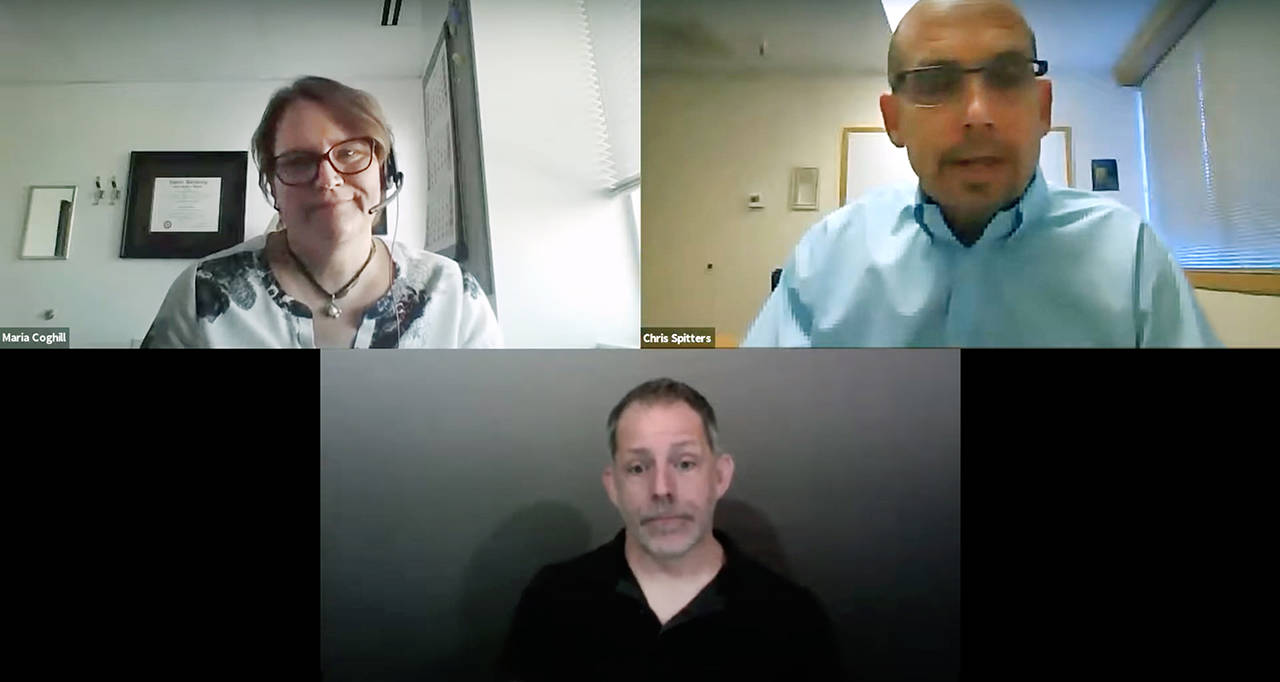EVERETT — COVID-19 infections are continuing to decline in Snohomish County from a peak in mid-July, but health leaders are urging everyone to keep wearing masks and limiting social interactions.
The county recorded 48 new COVID cases per 100,000 residents in the latest two-week tally, according to health district data. In July, that number was near 100. Hospitalizations from the virus are also declining.
“Right now, it’s really about weathering the storm of activity from our second wave,” Dr. Chris Spitters, the county’s top health officer, told reporters Tuesday. “We’ve got a long way to go to get to where I consider a comfort zone, but things are looking much better and sustained over time.”
However, Spitters is concerned that Labor Day celebrations could cause another rise in infections.
Previously, the county reported case increases in the weeks following both Memorial Day and the Fourth of July
“We’re hoping for a little better of an outcome” with Labor Day, Spitters said. It will take one to two weeks to see if the holiday led to new infections, he said.
Meanwhile, the health district is having trouble reaching some people who are infected with the virus.
In recent weeks, tracers made contact with about 70% of new cases within 24 hours of a positive test result, according to a health district report. Within 48 hours, it’s about 80%.
“After that, it really drops off,” Spitters said. “We still have about 20% of cases that are not responding to our calls.”
Anyone who tests positive for COVID should answer their phone, even if it says potential spam or is from an unknown number, he said.
“If it’s a phishing attack, hang up. But if we say we’re the health district, please continue on the call and finish with us,” he said. “If you have any doubts, ask a few questions and see if we can identify you.”
Additionally, the health district’s COVID testing is now open to everyone.
Previously, people needed to experience symptoms, be exposed to someone who tested positive or be in another higher-risk group to get tested.
If the demand for testing exceeds capacity, the health district may reinstate those restrictions, Spitters said.
To schedule an appointment, visit www.redcap.link.Snohomish-COVID19-Testing.
The county has also set up a phone line to help with test registration for those who don’t have internet access or speak a language other than English. The number is 425-258-8425, and the line is open Monday through Friday from 8:30 a.m. to 4:30 p.m.
During Tuesday’s call with reporters, Spitters was joined by Maria Coghill, an Everett resident who tested positive for COVID in the spring.
“It was different than anything I had ever experienced before,” she said.
Coghill, 44, said she was exposed to the virus during a meet-and-greet in April for a new job.
“I had shaking chills one evening and then just sort of this feeling that something wasn’t right,” she said. “… That was on a Thursday night. And then the following Wednesday, after a workout, my chest started to hurt. And it hurt to breathe and I came down with a cough.”
Her first COVID test came back negative. An X-ray showed she might have had pneumonia.
“My cough got worse to the point where I couldn’t talk without coughing,” she said. “It’s hard to explain. It was different than anything I’d ever experienced before, but I just, I could breathe and my oxygen saturations were OK but it hurt, just taking a breath hurt.”
A week later, she was still feeling ill. A second test showed she was positive for the virus.
Coghill spent the next two weeks in bed.
“My energy level was really low,” she said. “I would just try to take a shower and I’d have to sleep for hours.”
It wasn’t until about six weeks after developing symptoms that she could go for walks again. Even then, sometimes the exercise was too much.
“Typically, my resting heart rate is in the low 50s,” she said. “I would just be sitting watching TV with my family and it would like shoot up into the 90s, and this would just happen periodically with no warning.”
After two months, she felt normal again. Then, she developed Bell’s palsy in the right side of her face, and previous symptoms returned.
“Luckily, I don’t have the paralysis and drooping, but I have the tingling and the burning in my face. My sense of taste and smell have been altered again, but it’s metallic and like mineral tasting. I do continue to have bouts of fatigue, and then every once in a while I’ll get this sensation in my lungs where it feels like a kitchen sponge that’s like full of water. It just feels really boggy and heavy, and I can still breathe but it hurts.”
Through it all, she said, she feels lucky.
None of her family members became ill with the virus, her Bell’s palsy is beginning to improve and she can exercise again.
“But, you know, it’s worrisome, especially as you hear about these people who have long-term impacts and I wonder what will be in store, if there will be continued long-term effects,” she said.
Joey Thompson: 425-339-3449; jthompson@heraldnet.com. Twitter: @byjoeythompson.
Talk to us
> Give us your news tips.
> Send us a letter to the editor.
> More Herald contact information.

























